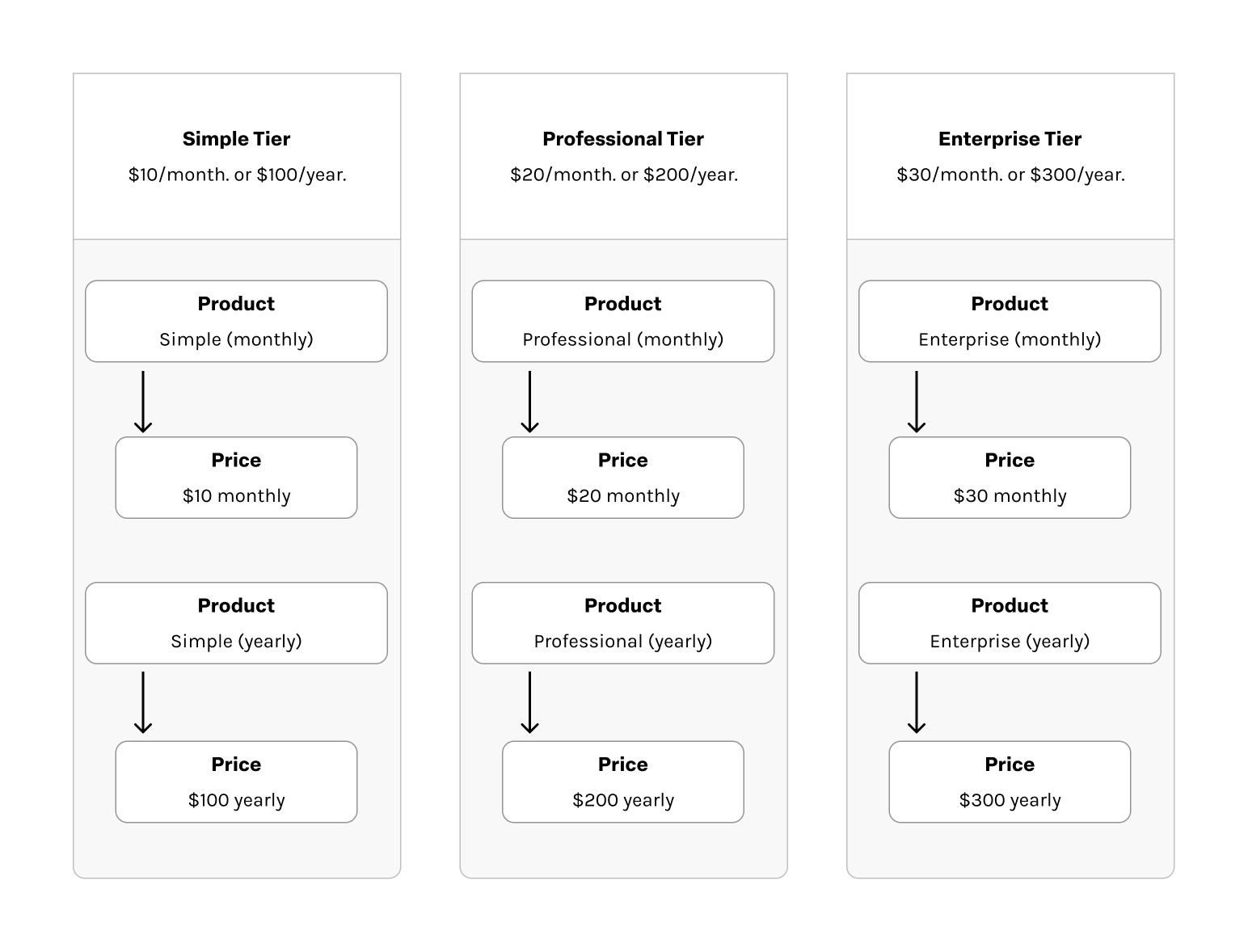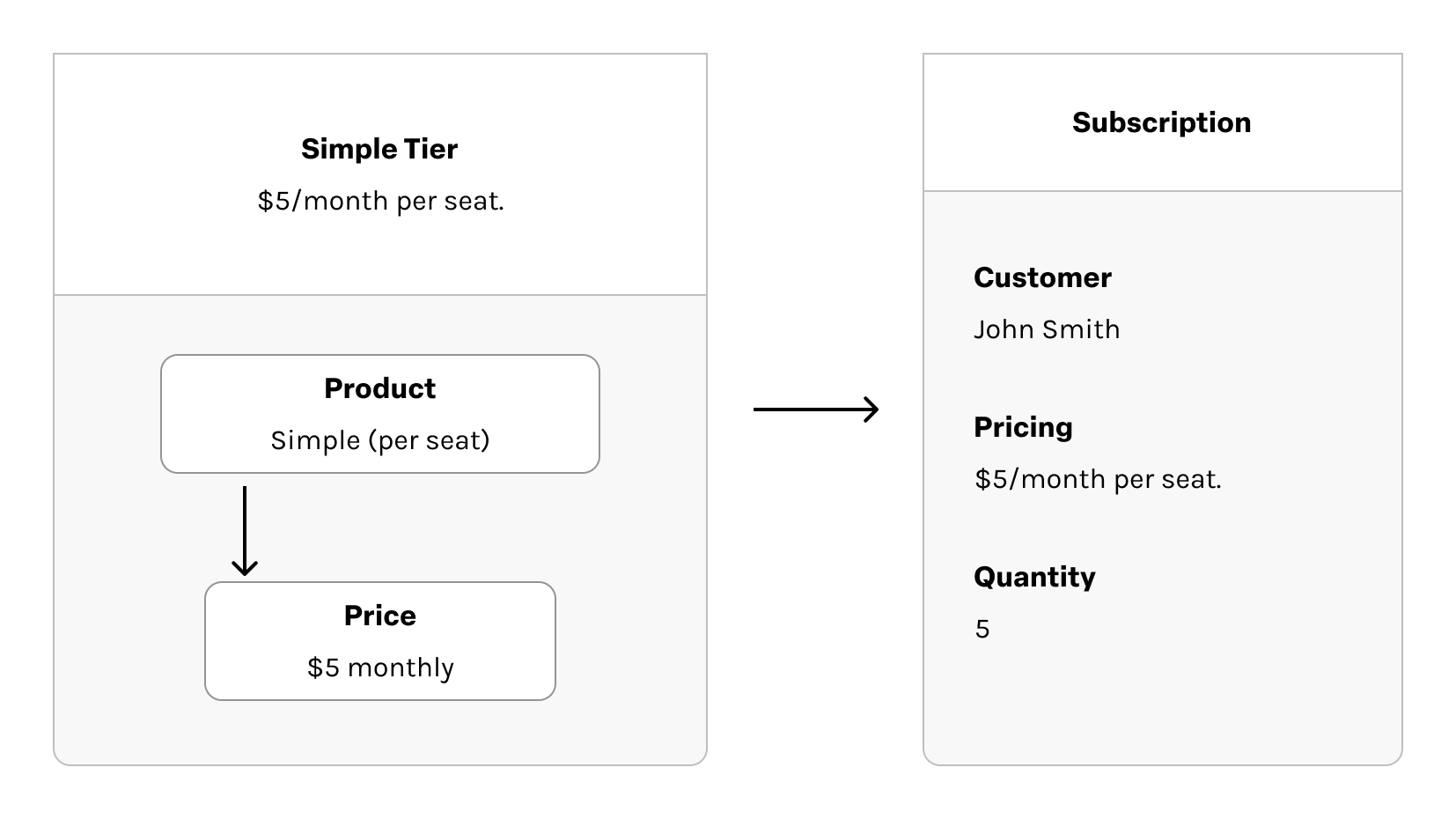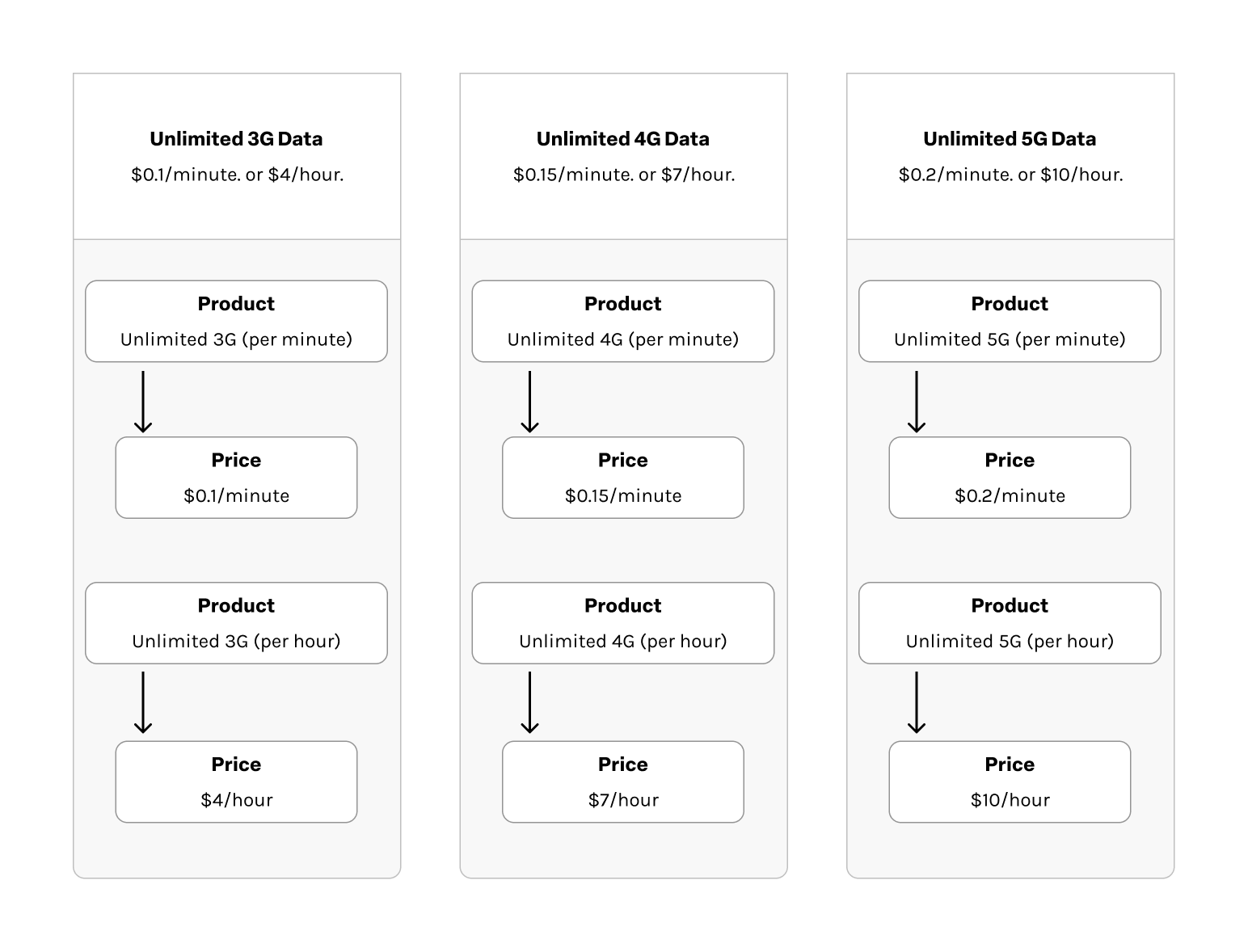Recurring pricing models
Pricing models are the structures of how you charge your customers on Radom. With the Product object, you can build your product, its pricing and how you charge for it.
Flat rate: Good-better-best
SaaS businesses commonly provide their customers with various service tiers to choose from, known as the good-better-best pricing model. This model offers customers a flat-rate pricing structure, with the option to select a service tier that best fits their needs: good, better, or best.
Picture a SaaS business called SalesPower that sells a sales platform. They offer three difference services: simple, professional and enterprise. For each service, they offer both a monthly and a yearly plan.
In this example, SalesPower has three products: Simple, Professional, Enterprise.
Each product has different pricing. The simple plan is 10 USD per month and 100 USD per year. In Radom, price is part of a product so multiple products have to be made for different pricing intervals.
Here's what the model looks like on Radom:

The above model is specific to Radom's APIs when using Payment Links, Checkout and other products. You can fully customize how products and pricing works using your SDK and/or interacting with our smart contract directly.
Per-seat
Per-seat pricing, also known as per-user pricing, is a common pricing model in the software-as-a-service (SaaS) industry. In this model, businesses are charged based on the number of individual users or "seats" they require for a particular software or service. This model is especially attractive to organizations that need a scalable solution, as it allows them to adjust the number of users according to their changing requirements.
SalesPower wants to offer a per-seat plan. They want to provide businesses with a cheaper alternative if they only need a specific number of users and not a company wide plan. SalesPower's customers select the number of seats they need, and SalesPower charges based on that amount.
To create this model, SalesPower creates a product with a price that represents each user. When the customer wants to purchase the service, they select the number of users they need.
Here’s what that model looks like on Radom:

Usage-based pricing
Usage-based pricing is a flexible and adaptive pricing model that charges customers based on their actual consumption of a product or service, rather than a fixed fee or subscription. This model is particularly attractive for businesses and customers who require on-demand access to services or resources, as it allows them to pay only for what they use.
Per-second, minute and hour
In industries such as telecommunications, usage-based pricing can take various forms, including per-minute or per-hour.
Telco3 is a telecoms company that allows customers to subscribe to unlimited data plans. They want to charge on a per-minute and per-hourly basis for these services.
Usage-based billing with short billing cycles like per-minute and per-hour allow access to a service in-real time whereas subscriptions are used for longer billing cycles with a fixed service.
For example, Telco3 could have a subscription for 1GB of 5G data at $25 per month and unlimited 5G data at $0.10 per-minute. A customer may prefer a usage-based pricing model if they only need to use the data for a short period of time.
Telco3 has three services: Unlimited 3G Data, Unlimited 4G Data, and Unlimited 5G Data.
Here’s what that model looks like on Radom:

Metered billing
Metered billing is a dynamic and precise pricing model that charges customers based on their actual usage of a service, typically quantified by specific metrics such as the number of requests, transactions, or data consumed. This model is particularly popular among API providers, as it allows them to tailor pricing to the individual needs and consumption patterns of their customers. By tracking and recording usage data, businesses can ensure fair and accurate billing, fostering trust and satisfaction among their customers.
Metered billing is collected in arrears, which means customers pay for their usage after the billing cycle, in contrast to per-seat and flat-rate models that require upfront payment. You must record usage of your service.
With a simple metered budget pricing model, you would set the price to '0' and set the billing cycle.
Then you would add the 'Metered Budget' value. The metered budget is the maximum amount you can charge the customer per billing cycle. You can set this or allow your customers to set this value.
APIFi, an example company, has launched a new API service that allows customers to make requests from their real-time trading database. They want to charge on a per-request basis at the end of each month for using this service.
Here’s what that model looks like on Radom:

Wallet on-file
With a metered budget, you can charge your customer up to the metered budget at any time during a billing cycle. We call this 'wallet on-file' at Radom, similar to the concept of storing a credit card on-file and charging at the end of the billing period.
Metered subscriptions
Metered subscriptions combine the predictability of a fixed monthly subscription with the flexibility of usage-based pricing, offering customers a balanced and adaptable solution. In this hybrid pricing model, customers commit to a package that includes a predefined amount of service access. If their usage exceeds the allocated amount during a billing cycle, customers are charged an overage fee based on their additional usage. This model allows businesses to cater to a wider range of customer preferences, providing a tailored approach to pricing that balances the need for predictable costs with the flexibility to accommodate fluctuations in usage.
LangConnect, a language tutoring service, offers live one-on-one language tutoring sessions with native speakers. Their pricing model is a mixture of a monthly subscription with a metered budget for overage charging.
If a customer has committed to a package with a specific number of hours of lessons per billing cycle (e.g., 10 hours for $200 per month) and exceeds the allocated hours, they are charged an overage fee of $30 per additional hour.
For example, a customer subscribes to the 10-hour package for $200 per month. If they use 11 hours during the billing cycle, they would be charged an overage fee for the extra 1 hour used (1 hour x $30 = $30). Their total bill for that cycle would be $230 ($200 for the initial 10 hours + $30 in overage fees).